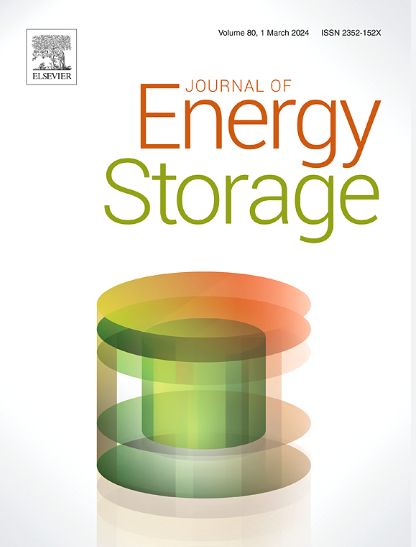Janus POSS-based hydrogel electrolytes with high-ionic conductivity and low-temperature-resistance for all-in-one flexible supercapacitors
IF 8.9
2区 工程技术
Q1 ENERGY & FUELS
引用次数: 0
Abstract
With the continuous advancement of smart wearable devices and flexible electronics, flexible hydrogel supercapacitors are increasingly becoming one of the ideal wearable energy storage systems due to their high water content and excellent mechanical flexibility. However, it remains a challenge for flexible hydrogel supercapacitors to maintain sufficient flexibility and satisfactory electrochemical performance at sub-zero temperatures. In this study, we developed an innovative hydrogel electrolyte by integrating 2-hydroxypropyl-β-cyclodextrin (HP-β-CD) into the hydrogel network structure of water-soluble Janus-type polyhedral oligosiloxane (AS-POSS)-based hydrogel. This strategic integration significantly enhanced the ionic transport efficiency and mechanical properties of the hydrogel. Our findings revealed that the modified hydrogel electrolyte exhibited not only excellent flexibility (1208.6 % at 25 °C and 1006.3 % at −40 °C) but also impressive ionic conductivity (86.6 mS cm−1 at 25 °C and 73.2 mS cm−1 at −40 °C). The integrated supercapacitor, featuring low interfacial resistance, was successfully fabricated via in situ polymerization of aniline. This supercapacitor exhibits a high areal capacitance of 1158.67 mF cm−2 at a current density of 0.2 mA cm−2 and a capacitance retention of >95 % in 2000 charge/discharge cycles, surpassing the performance of most previously reported integrated supercapacitors. This approach enhances the mechanical properties and electrical conductivity of the hydrogel electrolyte, offering a potential application for hydrogel supercapacitors in flexible energy storage devices.
Janus基于poss的水凝胶电解质,具有高离子电导率和耐低温性能,用于一体化柔性超级电容器
随着智能可穿戴设备和柔性电子产品的不断进步,柔性水凝胶超级电容器因其高含水量和优异的机械灵活性,越来越成为理想的可穿戴储能系统之一。然而,如何在零下温度下保持足够的柔韧性和令人满意的电化学性能仍然是柔性水凝胶超级电容器面临的挑战。在本研究中,我们将2-羟丙基-β-环糊精(HP-β-CD)整合到水溶性janus型多面体低聚硅氧烷(AS-POSS)基水凝胶的水凝胶网络结构中,开发了一种创新的水凝胶电解质。这种战略性整合显著提高了水凝胶的离子传输效率和力学性能。我们的研究结果表明,改性的水凝胶电解质不仅具有优异的柔韧性(25°C时为1208.6%,- 40°C时为1006.3%),而且具有令人惊叹的离子电导率(25°C时为86.6 mS cm - 1, - 40°C时为73.2 mS cm - 1)。采用苯胺原位聚合法制备了具有低界面电阻的集成超级电容器。该超级电容器在电流密度为0.2 mA cm - 2时显示出1158.67 mF cm - 2的高面电容,并且在2000次充放电循环中电容保持率为95%,超过了之前报道的大多数集成超级电容器的性能。这种方法提高了水凝胶电解质的机械性能和导电性,为水凝胶超级电容器在柔性储能装置中的应用提供了潜在的应用前景。
本文章由计算机程序翻译,如有差异,请以英文原文为准。
求助全文
约1分钟内获得全文
求助全文
来源期刊

Journal of energy storage
Energy-Renewable Energy, Sustainability and the Environment
CiteScore
11.80
自引率
24.50%
发文量
2262
审稿时长
69 days
期刊介绍:
Journal of energy storage focusses on all aspects of energy storage, in particular systems integration, electric grid integration, modelling and analysis, novel energy storage technologies, sizing and management strategies, business models for operation of storage systems and energy storage developments worldwide.
 求助内容:
求助内容: 应助结果提醒方式:
应助结果提醒方式:


